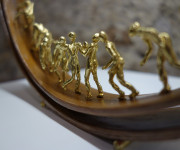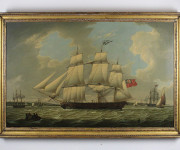Recent archaeological excavations, supported by the Royal Commission for AlUla (RCU), have unveiled intriguing insights into the Neolithic communities of north-west Arabia during the late 6th millennium BCE. These groundbreaking discoveries shed light on the intricacies of their “complex and sophisticated ritual practices.”
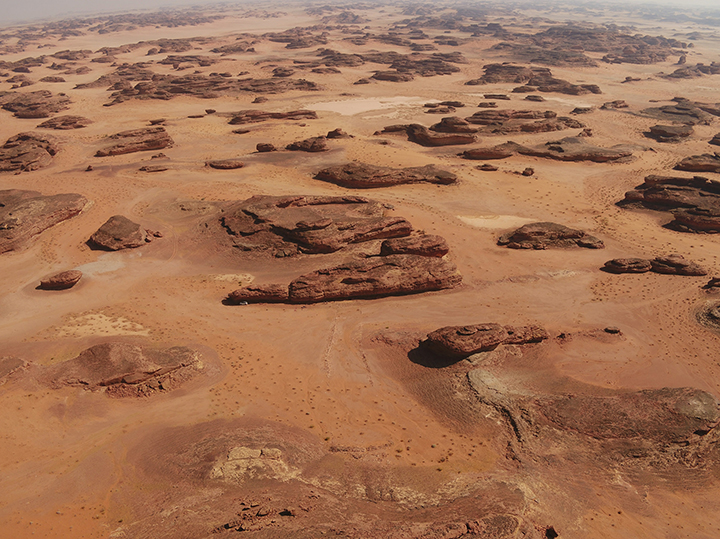
The outline of the Kennedy team’s mustatil is at the forefront of this image of the landscape east of AlUla. They describe the location as “essentially hidden in the sandstone canyons”. Photo – courtesy of Hugh Kennedy, AAKSA / RCU ©
The findings offer a fresh perspective on the social, cultural, and spiritual context of the ancient inhabitants of this region, expanding our understanding in unexpected ways. Researchers underscore the communal nature of these rituals, suggesting that individuals may have undertaken journeys to prehistoric stone structures known as “mustatils” to partake in these ceremonies, potentially marking one of the earliest pilgrimage traditions. Additionally, the presence of a greater variety of domestic animal offerings reinforces the pastoral nomadic identity of the community, implying that the construction of mustatils may have served as a means of fostering social bonds or territorial markers.
Mustatils, defined by their large-scale, open-air rectangular structures with low stone walls, initially puzzled researchers. However, ongoing excavations since 2018 have gradually unveiled their ritual significance, providing deeper insights into these practices.
The outcomes of these two studies have undergone peer review and have been recently published. One study, led by Dr. Wael Abu-Azizeh of the Archéorient Laboratory and France’s Lyon 2 University, is featured in the book “Revealing Cultural Landscapes in North-West Arabia,” edited by an expert team led by Dr. Rebecca Foote, Director of Archaeology at RCU. The second study, headed by Dr. Melissa Kennedy from Australia’s University of Sydney, was published in the journal PLoS One in March.
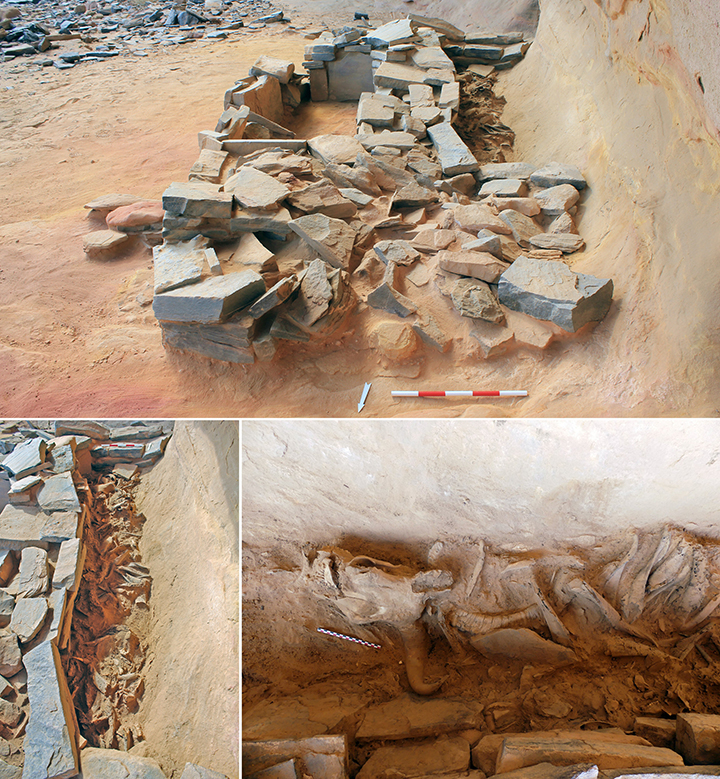
At top is a general view of the SU100 platform; at bottom are details of the horn chamber. Photo – courtesy of Wael Abu-Azizeh et al 2022 / RCU ©
In Dr. Abu-Azizeh’s 2018 excavation, known as the “Horn Chamber,” located at site IDIHA-0000687 northeast of AlUla and dating back to circa 5300-5000 BCE, the team uncovered a unique assemblage of horns and skull fragments. Notably, about 95% of these fragments were from domestic species, such as goats, sheep, and cattle, with the remainder from wild species like gazelle, Nubian ibex, and aurochs. A thin layer of twigs beneath the assemblage hinted at the preparation that went into this ritual. Researchers propose that these offerings were likely made during a single ceremony, with pastoral nomads presenting them as part of the ritual performance, creating a collective identity for their social group.
In Dr. Kennedy’s 2019 study, conducted at site IDIHA-0008222 within dense sandstone canyons east of AlUla and dating to circa 5200-5000 BCE, a chamber containing horns and skull parts was discovered. Unlike the first excavation, these bones appeared to have been deposited over multiple phases, spanning a generation or two. Most of the fragments were from cattle, along with several from goats. Notably, the central element of the shrine was an upright stone, interpreted as a “betyl,” acting as a mediator between humans and the divine. This discovery could represent one of the earliest known betyls in the Arabian Peninsula, and the repeated use of the shrine over the years suggests one of the earliest forms of “pilgrimage” in the region.
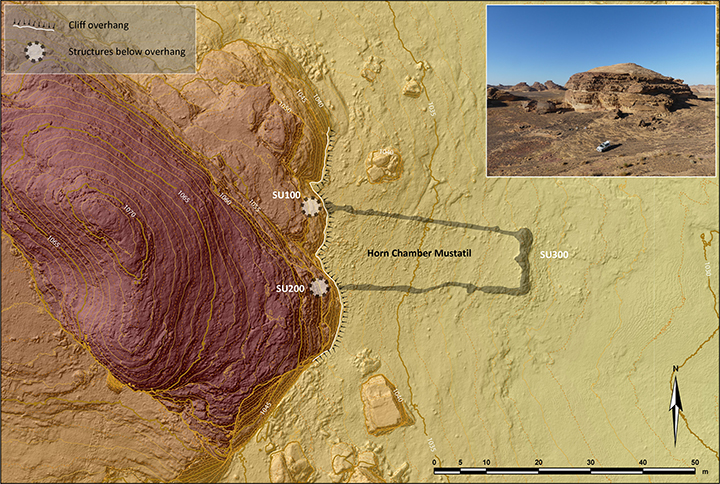
In this overview of the Horn Chamber Mustatil (at IDIHA-0000687), SU300 marks the eastern wall of the mustatil, SU200 marks a stone cairn and SU100 marks the 7×2.5m platform containing the horn chamber. The cliff overhang protected the horn chamber from exposure to the elements, which accounts for the exceptional state of preservation. Photo – courtesy of Wael Abu-Azizeh et al 2022 / RCU ©
Interestingly, researchers speculate that the placement of mustatils might have had ecological significance, possibly linked to ensuring fertility and sustaining rain in an increasingly arid climate. This theory opens up avenues for future research into the region’s environmental history.
The Royal Commission for AlUla (RCU) continues to advance archaeological research and cultural heritage preservation in the region. They are set to host the inaugural AlUla World Archaeology Summit from September 13-15, 2023, providing a platform for collaboration and knowledge exchange across various disciplines.
This summit, bringing together experts from academia, government, non-governmental organizations, industry, and the next generation of archaeologists, aims to enrich the archaeological community, protect shared history, and explore the transformative potential of archaeology and cultural heritage in society.
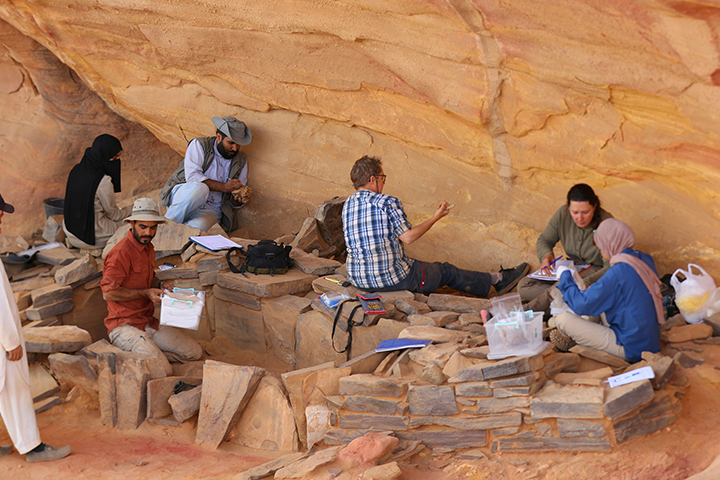
The team led by Dr Wael Abu-Azizeh excavates the chamber that contained “an exceptional discovery” of skull and horn fragments. Photo – courtesy of Muhammad Al-Dajani / RCU ©
The Royal Commission for AlUla (RCU), established in July 2017, is dedicated to preserving and developing the culturally and naturally significant region of AlUla in north-west Saudi Arabia. Their long-term plan focuses on responsible, sustainable urban and economic development while preserving the area’s heritage and aligning with the goals of Saudi Arabia’s Vision 2030 program. Their initiatives encompass archaeology, tourism, culture, education, and the arts, reflecting a commitment to economic diversification, community empowerment, and heritage preservation.

